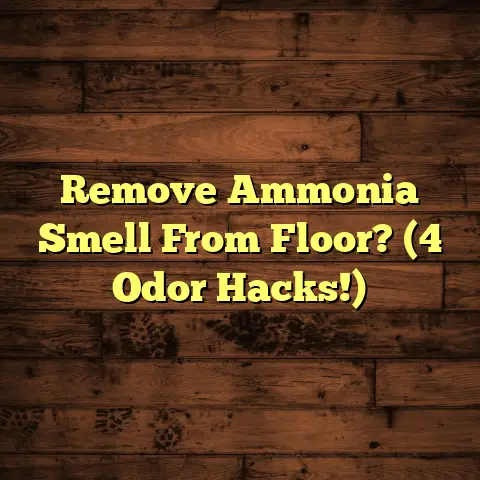Simple Green On Floors: Is It Safe To Use? (3 Warnings!)
I’ve seen it all – from pet stains that could rival abstract art to sticky messes that defy explanation.
And let me tell you, the quest for the perfect floor cleaner is a never-ending saga.
We’re all looking for that magic bullet, right?
Something that tackles grime without turning our homes into toxic waste zones.
Enter Simple Green, a name that pops up a lot in the conversation.
But is it really the eco-friendly savior we’ve been waiting for?
Or could it be a wolf in sheep’s clothing for your precious floors?
I’ve seen firsthand the damage that the wrong cleaner can inflict, and I’m here to share my knowledge.
Let’s dive in and uncover the truth about Simple Green and your floors.
Section 1: Understanding Simple Green
1. Overview of Simple Green
Simple Green isn’t just one product; it’s a whole family of cleaning solutions.
The brand prides itself on being a safer, more environmentally conscious alternative to harsh chemicals.
Their mission is to provide effective cleaning power without compromising the health of your family or the planet.
That’s a goal I can definitely get behind!
Simple Green has become a household name, especially for those of us trying to make eco-friendly choices.
2. Ingredients in Simple Green
Now, let’s peek under the hood and see what makes Simple Green tick.
The exact formula varies depending on the specific product, but some common ingredients include:
- Water: The base for most cleaning solutions.
- Nonionic Surfactants: These guys break down grease and dirt, lifting them away from surfaces.
- Anionic Surfactants: These help to create suds and keep the dirt suspended in the water.
- Solvents: These help to dissolve tough stains and grime.
- Chelating Agents: These bind to minerals in hard water, preventing them from interfering with the cleaning process.
- Fragrance: To leave your home smelling fresh and clean.
The beauty of Simple Green (at least on paper) is that many of these ingredients are biodegradable and non-toxic.
That said, “non-toxic” doesn’t always mean “harmless,” especially when it comes to your floors.
Section 2: Types of Flooring Materials
1. Common Flooring Types
Okay, let’s talk about the stars of the show: your floors!
Here’s a quick rundown of some common types:
- Hardwood: Classic, beautiful, but also sensitive to moisture and harsh chemicals.
- Laminate: A more affordable alternative to hardwood, but prone to warping if exposed to too much water.
- Tile: Durable and water-resistant, but grout can be a pain to keep clean.
- Vinyl: Versatile and budget-friendly, but can be scratched or damaged by abrasive cleaners.
- Carpet: Cozy and comfortable, but a magnet for dirt, stains, and allergens.
Each of these materials has its own unique properties and requires a specific approach to cleaning.
2. Interactivity of Cleaning Products with Flooring
This is where things get interesting.
Different cleaning products react differently with various flooring materials.
What works wonders on tile might wreak havoc on hardwood.
Using the wrong cleaner can lead to:
- Discoloration: Fading or staining of the flooring material.
- Damage to the Finish: Dullness, scratching, or peeling of protective coatings.
- Warping: Buckling or bending of the flooring material due to moisture absorption.
- Residue Buildup: A sticky or dull film that attracts dirt and grime.
Trust me, I’ve seen it all.
And repairing or replacing damaged flooring is a costly headache you definitely want to avoid.
Section 3: Safety of Simple Green on Floors
1. General Safety of Simple Green
So, where does Simple Green fit into all of this?
In general, Simple Green is considered a safer cleaning option compared to many harsh chemicals.
It’s often marketed as non-toxic, biodegradable, and safe for use around children and pets.
The company often touts certifications from organizations like Green Seal, which indicates that the product meets certain environmental standards.
However, it’s crucial to remember that “safer” doesn’t always mean “completely safe” for every surface and situation.
2. Case Studies and User Experiences
Let’s take a look at what real people are saying about using Simple Green on their floors:
- Positive Experiences: Many users report success using Simple Green to clean tile, vinyl, and even some types of hardwood.
They praise its effectiveness at removing grease and grime without leaving a harsh chemical smell. - Negative Experiences: Some users have reported issues with Simple Green dulling the finish on their hardwood floors or leaving a sticky residue.
Others have experienced skin irritation or respiratory problems after using the product.
It’s important to note that these are just anecdotal experiences.
Results can vary depending on the type of flooring, the concentration of the cleaner, and individual sensitivities.
3. Scientific Research and Expert Opinions
Unfortunately, there’s not a ton of independent scientific research specifically focused on the long-term effects of Simple Green on various flooring types.
However, experts generally agree that while Simple Green is a milder cleaner than many alternatives, it’s still essential to use it with caution.
The Environmental Protection Agency (EPA) has recognized Simple Green as a Safer Choice product, which means that it meets certain criteria for human health and environmental safety.
However, the EPA also emphasizes that even Safer Choice products should be used according to the manufacturer’s instructions.
Section 4: Warning #1: Potential Damage to Certain Flooring Types
Alright, let’s get to the nitty-gritty.
Here’s where I’m going to highlight the potential issues.
1. Hardwood Floors
This is where I see the most problems.
Hardwood floors are notoriously sensitive to moisture and harsh chemicals.
Simple Green, while generally milder than many cleaners, can still damage the finish on hardwood floors if used improperly.
The alkaline nature of Simple Green can break down the protective coating, leading to dullness, discoloration, and even warping.
I’ve seen floors where repeated use of Simple Green has completely stripped the finish, leaving the wood exposed and vulnerable to damage.
Example: I was called to a house where the homeowner had been using Simple Green to clean their hardwood floors for years.
Over time, the finish had become dull and cloudy, and the wood was starting to show signs of water damage.
The only solution was to sand down the floors and refinish them, a costly and time-consuming process.
2. Laminate and Vinyl
Laminate and vinyl floors are generally more durable than hardwood, but they’re not immune to damage.
Simple Green can potentially cause warping or dulling of these materials, especially if used in high concentrations or left to sit on the surface for too long.
The chemicals in Simple Green can also break down the adhesive that holds the laminate layers together, leading to bubbling or peeling.
Example: I inspected a vinyl floor that had developed a cloudy film after being cleaned with Simple Green.
The homeowner had used a concentrated solution and hadn’t rinsed the floor properly.
The residue buildup attracted dirt and grime, making the floor look even worse.
3. Tile and Grout
Tile itself is pretty resilient, but grout is another story.
Grout is porous and can easily absorb dirt, stains, and cleaning solutions.
Simple Green can potentially discolor or degrade grout lines, especially if used in high concentrations or left to soak for extended periods.
I’ve seen cases where Simple Green has caused grout to crumble or even fall out completely.
Example: I had a client who used Simple Green to clean their tile floors, but they didn’t rinse the grout properly.
Over time, the grout became discolored and started to crumble.
They ended up having to regrout the entire floor, which was a messy and expensive project.
Section 5: Warning #2: Respiratory and Skin Irritation Risks
1. Chemical Sensitivities
While Simple Green is marketed as a safer alternative to harsh chemicals, it’s not entirely free of potential irritants.
Some individuals may be sensitive to certain ingredients in Simple Green, such as fragrances or surfactants.
These sensitivities can manifest as:
- Respiratory Issues: Coughing, wheezing, shortness of breath.
- Skin Irritation: Rashes, itching, redness.
- Eye Irritation: Burning, stinging, watering.
If you have known chemical sensitivities or allergies, it’s always a good idea to test Simple Green on a small, inconspicuous area before using it on your entire floor.
2. Proper Ventilation and Protective Measures
Even if you don’t have known sensitivities, it’s still important to take precautions when using Simple Green.
Always use it in a well-ventilated area to minimize the risk of respiratory irritation.
Consider wearing gloves to protect your skin from potential irritation.
If you experience any adverse reactions, discontinue use immediately and consult a doctor.
Section 6: Warning #3: Misuse and Overuse Consequences
1. Concentration and Dilution
One of the biggest mistakes I see people make is not following the manufacturer’s instructions regarding dilution.
Using too much Simple Green can lead to:
- Residue Buildup: A sticky or dull film that attracts dirt and grime.
- Damage to the Finish: Dullness, discoloration, or warping of the flooring material.
- Increased Risk of Irritation: Higher concentrations of chemicals can increase the risk of skin or respiratory irritation.
Always dilute Simple Green according to the instructions on the label.
When in doubt, it’s always better to use a weaker solution than a stronger one.
2. Frequency of Use
Even if you’re using Simple Green correctly, using it too frequently can still cause problems.
Overuse can lead to:
- Buildup of Chemicals: Even if you’re diluting the product properly, repeated use can lead to a buildup of chemicals on your floors.
- Damage to the Finish: Frequent cleaning can wear down the protective coating on your floors, making them more vulnerable to damage.
I recommend cleaning your floors only when necessary.
For regular maintenance, a simple damp mop with plain water is often sufficient.
Conclusion: Recap and Final Thoughts
So, is Simple Green safe to use on your floors?
The answer, as with most things in life, is: it depends.
It can be a safe and effective cleaning option, but only if used properly and on the right type of flooring.
Let’s recap the three main warnings:
- Potential Damage to Certain Flooring Types: Hardwood, laminate, and grout are particularly vulnerable.
- Respiratory and Skin Irritation Risks: Be mindful of chemical sensitivities and take precautions.
- Misuse and Overuse Consequences: Always follow dilution instructions and avoid cleaning too frequently.
Ultimately, the decision of whether or not to use Simple Green on your floors is up to you.
I hope this article has provided you with the information you need to make an informed choice.
Remember, your floors are a valuable investment. Take care of them!





